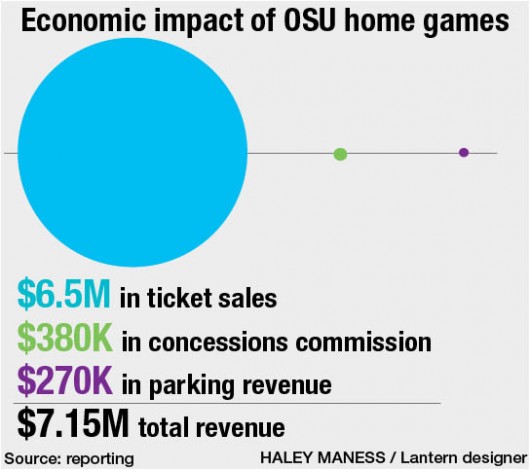With room for nearly 108,000 people, Ohio Stadium brings in fans by the groves on gameday, and it also brings in their money — about $7.15 million to be exact, an athletic department spokesman said.
That money, which is raked in via ticket sales, concessions and parking, has an impact on Columbus’s economy as well, some experts say.
Athletic department spokesman Dan Wallenberg said each home game brings in roughly $6.5 million from ticket sales for tickets priced at $79. All individual game tickets are $79 with exception of premium games, according to an OSU website.
Earlier this year, OSU expanded Ohio Stadium’s seating by 2,500 seats, making it the third-largest stadium in the country. The added seats were part of a larger $13.7 million renovation to the stadium, which also included the installation of permanent lights and new field turf.
However, Wallenberg said the university will not see any revenue from these seats for some time.
“The incremental revenue from the additional 2,500 seats is directed to the 10-year loan we have to pay for the addition of these seats and the new stadium permanent lights,” Wallenberg said in an email.
On top of the $6.5 million in ticket sales, the games also bring in $270,000 in parking revenue, and $380,000 in concessions commission for a total of $7.15 million in total revenue for each home game.
But Wallenberg said all of that revenue remains in the athletic department and is used to pay the visiting team and game expenses, which total about $1.4 million.
“The net income goes to support football and the general budget for the Department of Athletics,” Wallenberg said.
OSU home games end of bringing in a net income of approximately $5.75 million.
While the Department of Athletics is self-funded and receives a majority of its budget from the football program, some students said they would like to see that money spent in areas besides athletics.
“I’m not surprised that they pull in that much money, but I think it would be nice to see that spread around more,” said Jacob Stauffer, a second-year in engineering. “I’ve just never been a huge sports fan so I’d like to see some of that money going toward other campus things.”
Aside from tickets, concessions and parking, revenue is also brought in from other areas such as program sales and merchandise sales, however, OSU doesn’t see that income.
Program sales are controlled by IMG College and merchandise sales are managed by LIDS, Wallenberg said, so those companies keep the revenue for gameday sales.
IMG College has a 10-year, $107 million contract with OSU. And earlier this year, OSU signed a 10-year agreement worth $12.05 million with Indianapolis-based Hat World Inc., doing business as Lids Sports Group, which designated Lids the “official headwear retailer of OSU”.
Wallenberg said there has not been much change in net revenue per game the past few years but ticket revenue should see an increase because the additional 2,500 seats and an additional premium-priced game this year.
Last year saw only one premium-priced game, against Wisconsin on Sept. 28, with tickets selling for $110 each. Two premium-priced games were set for this year: the Virginia Tech game on Sept. 6 where tickets cost $110 each and University of Michigan game, set for Nov. 29, for which tickets are being sold for $150 each.
While these numbers have a direct impact on the Department of Athletics, a gameday’s economic impact on the Central Ohio economy is less evident, said Todd Nesbit, a senior lecturer in the Department of Economics.
“A lot of the research related to economic impacts of large sporting events is really quite mixed,” Nesbit said. “You’ll see impact studies that present really large numbers, unfortunately some of the assumptions in those seem to be overstated.”
Nesbit said the impact of these events tends to be much less than what people believe.
“Not all of the money that is being generated is actually a new expenditure,” Nesbit said. “If some folks are going to the OSU football games, it isn’t like if they weren’t going to the game that they wouldn’t be spending their money somewhere else in the area.”
The money spent by Central Ohioans is not where the true economic impact is seen, Nesbit said.
“The new expenditures are seen from those people who are coming from out of town,” Nesbit said. “That’s what is impacting our local economy in a positive manner. Anything from hotels to restaurants and bars will be impacted by people coming from out of town.”
But one thing that might not be impacted as much at OSU compared to other universities is hotel bookings, said Trevon Logan, an associate professor in the Department of Economics.
“Calculations like these are hard. Are people getting a lot of hotel rooms in Columbus? Maybe not because we are so centrally located here in Ohio and a lot of fans can get here within two hours or so,” Logan said.
A positive to having so many people living within close proximity to Ohio Stadium is the fact that it means more people, Logan said.
“We are going to get people who are going to the game, and we are going to get people who aren’t going to the game, such as tailgaters,” Logan said. “The question becomes, where are these people spending their money? Just around the campus area or around the entire Central Ohio area?”
Logan said a real economic impact is only seen if people plan to spend more money at an OSU game than they would otherwise on a gameday.
“If someone would normally go out and spend $20 on a Saturday but instead goes out and spends $30, the economic impact the game has is $10 not the entire $30,” Logan said.



